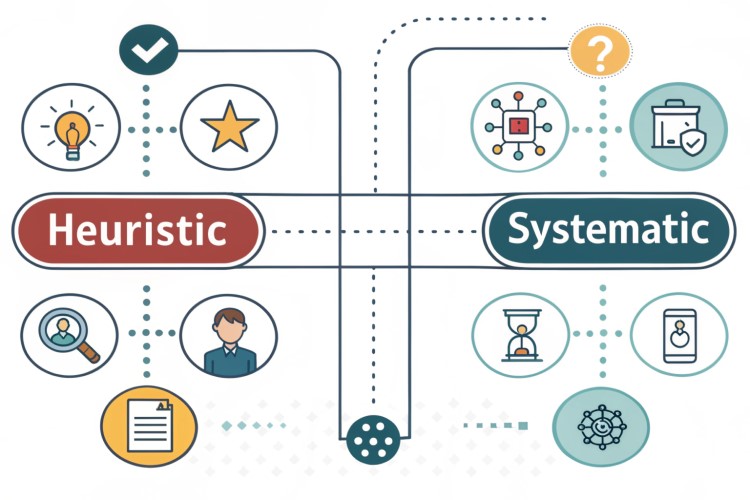
Sometimes customers want fast, simple answers based on basic information. At other times, they prefer to research deeply and compare many options. Both thinking styles matter for your marketing success. Therefore, you need strategies that work for both quick browsers and thorough researchers.
Research shows that 95% of purchasing decisions happen in the subconscious mind through mental shortcuts. Yet, customers also spend an average of 79 days gathering information for major purchases. This mix of fast and slow thinking shapes how people interact with your business.
You can apply these insights to improve your marketing approach. By matching your message to your customers’ thinking style, you build stronger connections. Additionally, you make it easier for customers to find and choose your products or services.
The way you present information affects how customers process it. Clear visuals and simple messages work well for quick decisions. Meanwhile, detailed content supports those who want to learn more. This balanced approach helps you reach more customers effectively.
Introduction to the Heuristic-Systematic Model: Quick vs. Detailed Processing
The Heuristic-Systematic Model helps explain how people process information, especially when making decisions. This model outlines two primary approaches: heuristic and systematic processing. Heuristic processing relies on mental shortcuts or “rules of thumb.” With this method, people make quick decisions based on cues like source credibility or familiarity. This approach often saves time and effort, allowing people to make decisions even with limited information.
In contrast, systematic processing involves a more thorough examination of information. When you use this approach, you analyze details, consider alternatives, and scrutinize evidence before reaching a conclusion. This approach is typically used in situations where decisions carry more weight, or when the information is complex. By engaging in deeper processing, you’re more likely to understand the full context and make more informed choices.
The Heuristic-Systematic Model suggests that people don’t always rely on just one approach. Instead, they may switch between heuristic and systematic processing based on factors like time, importance, and personal motivation. This flexibility allows individuals to adapt their decision-making strategy to different situations, balancing efficiency with accuracy. Understanding this model can enhance your ability to communicate effectively, tailoring messages that align with your audience’s preferred processing style.
How Heuristics Influence Consumer Decision-Making
The Heuristic-Systematic Model explains how consumers often rely on shortcuts, or heuristics, to make decisions. Heuristics allow people to decide quickly without engaging in deep analysis. One common heuristic is the “rule of thumb,” which means making choices based on simple, familiar guidelines. For example, if you usually buy products from a certain brand, you might choose it again because it has met your needs before. This reliance on past experience saves time and mental effort.
Brand familiarity also plays a significant role in consumer decision-making. When faced with multiple options, you might select a brand you recognize, assuming it’s trustworthy or reliable. This approach helps simplify choices, especially in busy or complex environments, where too much information can lead to decision fatigue. By choosing a known brand, consumers can feel more confident, reducing the need for extensive comparison.
Heuristics like these often lead to quicker, less effortful decisions, aligning well with the Heuristic-Systematic Model. While they can sometimes result in less optimal choices, they are beneficial for handling everyday decisions. By understanding how heuristics guide consumer behavior, businesses can shape their branding and marketing strategies to connect with customers on a more intuitive level.
The Role of Systematic Processing in High-Involvement Decisions
The Heuristic-Systematic Model explains that when facing high-involvement decisions, consumers often turn to systematic processing. In these situations, you engage in detailed analysis, evaluating all available information carefully before making a choice. This is especially common when decisions carry significant financial, emotional, or personal impact, such as buying a car, choosing a university, or selecting a healthcare plan. Here, consumers prioritize accuracy over speed, weighing pros and cons to reduce potential regrets.
Systematic processing involves critical thinking and an openness to new information. Instead of relying on brand recognition or past experience, you actively seek data, such as reviews, expert opinions, and product comparisons. You might also evaluate long-term consequences, considering how a decision aligns with your needs and values. This thorough approach reduces uncertainty, especially in complex decisions where a wrong choice can have lasting effects.
By acknowledging the role of systematic processing, the Heuristic-Systematic Model highlights how consumers shift between quick and detailed processing based on the stakes of each decision. In high-involvement contexts, systematic processing enhances confidence, as you base your choice on reliable information. For marketers and businesses, understanding this behavior allows them to provide transparent and comprehensive details, which can help consumers feel supported and informed during significant decisions.
Factors Affecting the Choice Between Heuristic and Systematic Processing
In the Heuristic-Systematic Model, several factors shape whether you engage in quick heuristic processing or take a more detailed systematic approach. One major factor is time pressure. When time is limited, you’re more likely to rely on heuristic shortcuts, using “rules of thumb” or past experiences to make decisions quickly. In contrast, when ample time is available, you may feel more comfortable analyzing details, leading to systematic processing.
Motivation also significantly influences your approach. When a decision is personally important or impacts your long-term goals, you tend to process information more systematically. High motivation often pushes you to seek accuracy and reduce the chances of regret by evaluating all available information thoroughly. However, if motivation is low, you might lean on heuristics, focusing on surface cues like brand familiarity or price alone.
The complexity of information further affects the choice between heuristic and systematic processing. When information is straightforward, it’s easier to rely on heuristic processing, making decisions based on simple cues. But with complex or technical information, systematic processing becomes essential. In these cases, breaking down details helps you make sense of the options, even though it requires more time and effort. Understanding these factors within the Heuristic-Systematic Model helps you assess when to use a more efficient heuristic or a deeper, systematic approach based on your context and needs.
Applications of the Heuristic-Systematic Model in Marketing Strategies
The Heuristic-Systematic Model offers marketers a valuable framework for tailoring messages based on how you approach decision-making. If you’re likely to make quick, heuristic-based decisions, marketers use straightforward messages with memorable visuals or phrases. This type of messaging relies on cues like brand reputation, simple benefits, or attractive imagery, making it easier for you to engage without a detailed analysis. For example, a familiar logo or an “on-sale” label can immediately grab your attention and influence your decision.
In contrast, when marketers anticipate that you will process information systematically, they focus on delivering detailed, informative messages. For high-involvement products, marketers might provide in-depth comparisons, detailed descriptions, and case studies to support their claims. This approach caters to your need for thorough evaluation, especially for complex products or big-ticket purchases. Information-rich content like white papers, customer testimonials, and technical specifications encourages systematic processing and boosts confidence in your choice.
Marketers often combine both strategies to reach a wider audience, as some consumers may prefer heuristic shortcuts while others seek detailed insights. For instance, an ad may feature both a catchy tagline (appealing to heuristic thinkers) and a link to detailed product information (for systematic processors). The Heuristic-Systematic Model helps marketers craft messages that not only engage different types of decision-makers but also strengthen your overall experience by providing information that matches your preferred processing style.
Balancing Heuristic and Systematic Approaches for Optimal Consumer Engagement
Understanding how customers make decisions can transform your marketing approach. The Heuristic-Systematic Model helps explain two main ways people process information and make choices. Your customers switch between quick mental shortcuts and deeper analysis when evaluating products or services.
Most people rely on mental shortcuts when they shop in familiar settings. Therefore, you can design simple visual cues and clear messages for these fast-thinking moments. Yet, customers also engage in detailed thinking for major purchases or new product categories. In these cases, they need complete product information and clear comparisons.
To reach customers effectively, you need to support both thinking styles. Consider how time pressure affects your customers’ decision-making process. When customers feel rushed, they lean more on quick judgments and familiar patterns. However, they take more time to research and compare options for important decisions.
Your marketing materials should match your customers’ mindset at different points. Use clear headlines and strong visuals for quick scanning. Then, provide detailed specs and thorough explanations for those who want to learn more. This balanced approach helps both quick browsers and careful researchers.
The key is to recognize when customers prefer each thinking style. For example, grocery shoppers often use quick decisions for regular items. Yet, they might carefully evaluate new health products. By matching your message to their thinking mode, you can connect better with customers at each step.
Remember that customers’ thinking patterns change throughout their day. Sometimes they want quick answers, while other times they need deep information. When you support both styles, you make it easier for customers to choose your products with confidence.
Conclusion
The Heuristic-Systematic Model gives you practical tools to reach customers more effectively. Your marketing can work better when you understand how people make decisions. By balancing quick mental shortcuts with detailed information, you build stronger connections with your customers.
First, notice how your customers react to different types of messages. Then, adjust your content to match their preferred thinking style at each step. When customers feel rushed, they appreciate clear, simple messages. However, they want more details and comparisons for bigger purchases.
You can improve your marketing by supporting both quick and thorough decision-making styles. Start with clear headlines and visuals that catch attention. Next, add depth with detailed information for customers who want to learn more. This approach helps you connect with different customers at their own pace.
Remember that customers switch between fast and slow thinking throughout their buying process. Sometimes they scan quickly, while other times they research carefully. Your marketing should support both styles to help customers feel confident about their choices. When you apply these insights from the Heuristic-Systematic Model, you create better experiences for your customers.


